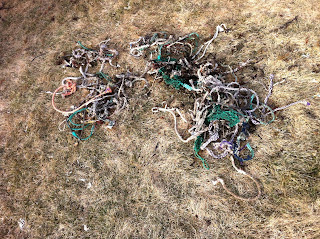With ice on the low foreshore and drifts of snow higher up, only the thin wrack line was thawed and searchable this day. I thought it was going to be a quick & unimpressive cleanup.
Until I started seeing these.
Vinyl scraps, from lobster traps. The huge mat of fine, pulverized seaweed (including all that white skeletal coralline algae) is a sign of a very gentle high-tide. One that lets the finest bits settle out on the sand without being washed back. The perfect conditions for the vinyl trap coatings.
So, my hour-and-a-half was quickly spoken for by this thin sliver of shoreline between ice and snow. In the end, of course, I found more than vinyl. Such as:
 |
| Coffeecup lids wash in every week |
All told, it was a shockingly big haul for a beach that was mostly unsearchable.
 |
| 76 pcs of rope, about 60 ft total |
 |
| 467 pcs of nonrope debris |
- Bldg material/furniture: 0
- Foam/styrofoam: 0
- Fishing rope/net: 76
- Fishing misc.: 422 (8 claw bands, 2 trap bumpers, 2 bait bags, 410 vinyl scraps!)
- Food-related plastics: 11 (bottlecap scrap, cap o-ring, 7 cup scraps, bread tag, fork scrap)
- Food-related glass/metal: 2 (aluminum can scraps)
- Nonfood/unknown plastics: 10 (bag scrap, bandaid, degraded detergent jug, 2 cable ties, 3 vinyl upholstery scraps, sleeve, duct tape)
- Scrap plastics: 20 ( 3 > 1" , 17 < 1" )
- Paper/wood: 0
- Non-plastic misc./unique: 2 (glove, metal washer)
All told, 498 pcs of the 543 -- 91.7% -- was plastic lobstering debris. As I describe in more detail in my Portland Press Herald blog piece, "A Vinyl Tide," someone will have to pay for this. We can start now, changing the way we fish our waters and paying the extra price at the plate for better gear in the ocean. Or we can leave it to our kids and grandkids.
One way or another, someone will have to pay.
Running YTD counts:
- Total pcs of litter -- 13508
- Pcs fishing rope -- 3775
- Vinyl lobster-trap scraps -- 5237



Harry, Maybe we could take a tip from the coffee industry (like Green Mtn Coffee). People shopping for coffee now have a choice, bird friendly, shade grown, organic, sustainablly grown and so on.
ReplyDeleteWhy couldn't the fishing industry offer plastic free lobster as an option? We have cage free eggs, why not cage free lobster-ok cage free is probably not feasible, however folks might pay a small premium for plastic free lobster.
Lots of people care and are concerned about plastic pollution. Lets give them a way to pay for changes now instead of passing the bill to their children and grandchildren.
Bernie
in Vermont
http://www.litterwithastorytotell.blogspot.com/
Hey Bernie!
DeleteI've been thinking in the same terms for some time. Same idea, using the "organic" model -- people willing to pay more for a product that is better for the world. It seems, really, the only way to make any inroads... Find a group of lobstermen willing to fish with only wooden traps and manila/hemp rope, natural buoys. Heavily market the upside of natural fishing & the downside of the plasticized gear, and see if people will pay more for a food that's caught with care. I think at least there's a hope for it.